Alfred Becker
| Alfred Becker | |
|---|---|
 Major Alfred Becker | |
| Born |
20 August 1899 Krefeld, German Empire |
| Died | unknown |
| Allegiance |
|
| Service/branch |
|
| Years of service | 1911–45 |
| Rank | Major |
| Commands held |
|
| Battles/wars |
|
| Awards | Iron Cross {II & I Class} |
Alfred Becker (20 August 1899 – unknown) was a German engineer and artillery officer who served during the First and Second World Wars. He was born in Krefeld. A mechanical engineer, he was best known for being the primary person responsible for converting captured vehicles and weapons into usable instruments for the German army.[1] Using his organizational and engineering skills, he converted the Hotchkiss plant near Paris into a vehicle modification and fabrication center. There he and the men from his artillery command converted large numbers of captured French equipment to mobilize German guns, rocket launchers and mortars. Becker was Germany's expert at acquisition and conversion of captured military equipment.
In addition to creating the conversion program in France, Becker was at the same time the commanding officer of the Sturmgeschütz-Abt. 200, a motorized assault gun battalion of the 21st Panzer Division.[2] He commanded this unit during its re-equipment in 1944, through the battles fought in Normandy and the retreat across France and Belgium, until his capture in Alsace on the French/German border in December 1944.
First World War
During the First World War Becker was an artillery officer, and was awarded the Iron Cross 2nd and 1st class in 1914.
Interwar period

Becker obtained a doctorate in mechanical engineering and was co-owner of the company Volkmann & Co. in Krefeld. He formed a small manufacturing firm, Alfred Becker AG of Bielefeld.
Second World War

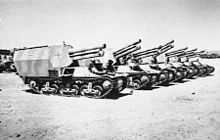
At the start of the war Becker was called up to serve in the 227th Infantry Division "Rhine-Westphalian", formed during the 3rd wave mobilization in August 1939 in Krefeld. He was assigned as an officer to the 15th Artillery Regiment, later the 227th Artillery Regiment of the division. During the fighting in Poland the division served with the 5th Army performing border protection in the Eifel region. In December 1939 it was assigned to the 6th Army and became a part of Army Group B in preparation for Fall Gelb. The following spring the division formed part of the 18th Army engaged in the offensive into the Netherlands and Belgium. The division advanced through Enschede and Deventer, before being held up for three days at the Grebbe line. The Leibstandarte SS Adolf Hitler, an SS regiment under Kurt Meyer attached to the 227th for the campaign, created the breakthrough at the Grebbe line. The 227th then crossed the Leie and continued its advance, taking Amersfoort just before the Dutch capitulation.
All guns in Becker's artillery regiment were pulled by horsedrawn limbers and caissons, which was standard practice for the infantry divisions of the Heer.[3] After reaching the Dutch artillery depot at Amersfoort Becker discovered a large number of vehicles which he believed he could use. Becker equipped both his artillery battery and his division's reconnaissance battalion with motorized transport for their guns. After this he began to consider the benefits that could be derived from mounting the guns directly onto the motorized carriages, as he had done with the pre-production Hummel conversions.
In July 1940 following the victory in France, the 227th Division performed occupation, security and coastal defense duties along the Normandy coast near Le Havre.[4] Using his engineering and manufacturing skills and the men from his battalion, Becker mobilized a complete battery of self-propelled artillery, making use of the under-carriages of the Vickers Mk.6 to motorize twelve of the battalion's 105 mm leFH 16 howitzers, and six of the 150 mm sFH 13, along with twelve more munitions carrying versions of the Mk.6.[1] The batteries initial test firing was done at the range of Harfleur near Le Havre, France. The complete battery was tested at the training grounds at Beverloo, Belgium.
In December 1941 the 227th Division was transferred to Army Group North on the Eastern Front. The division became engaged in continual fighting there in and around Leningrad.[4] The German Army High Command, the Oberkommando des Heeres or OKH, became aware of Becker's creations and in early 1942 transferred Becker to Alkett in Berlin-Spandau to help them create self-propelled artillery pieces, using captured French Lorraine Schlepper ammunition carriers.[1][5] Becker converted these vehicles to carry the 150 mm sFH 18.[6] On 2 September 1942 Becker was allowed to demonstrate them in the garden of the Reich Chancellery, with Adolf Hitler in attendance. This vehicle met with great approval from the OKH. The vehicles were shipped to North Africa to supplement Erwin Rommel’s Afrika Korps in the desert.[N 1] Following this demonstration Hitler commissioned Becker to collect all reusable equipment in France and ordered him to convert them into enough usable equipment to form "at least" two panzer divisions.
Paris Baukommando Becker
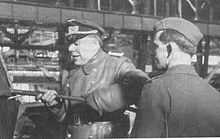


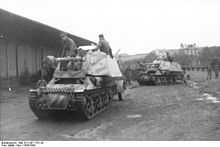
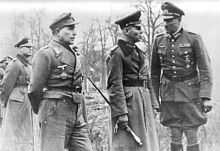
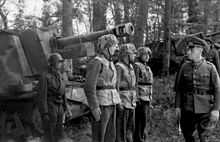
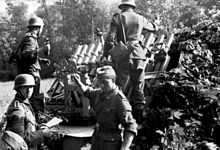
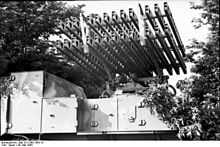
The task before Becker was enormous. A huge quantity of captured or damaged allied military vehicles were available scattered throughout France. Some use had already been made of undamaged French armoured vehicles, either as training vehicles or sent abroad to equip various Axis allied nations or used in police units. Built with a small, one man turret mounting a small caliber gun, they were of little value in 1942 for combat against such weapons as the Russian T-34. Their primary use to the German army up to this point had been as trophies, a symbol of their victory over France. Though lightly armoured and under-gunned by the combat standards of the day, these were fully tracked vehicles, a feature which Becker believed could be usefully exploited. In addition to the wrecked and captured French and British tanks, Becker also had access to a large number of soft-skinned half-tracked vehicles such as the SOMUA MCG and the smaller Unic P 107.[7]
Setting up headquarters at Maisons-Laffitte, the vehicles were collected at the Hotchkiss works near Paris.[8] The vehicles where refitted and repaired by importance, all of one type in one step. The remaining spare parts were stored away, and left over materials were shipped back to the steelworks.[1] Becker's basic idea for the conversion was straightforward in principle: he built a prototype of the replacement superstructure out of wood and sent it to Alkett. Alkett then produced a run of replacement superstructures out of steel. These were then shipped back to France where Becker had completed the engineering plans for the conversion. The Hotchkiss assembly line was then brought up again, the conversion process was streamlined and a run of assembly was completed.
The innovative aspect of the work was the battle value assessment of the vehicles, determining the most effective use of each vehicle type in relation to the existing demands. This was coupled with an accurate classification of each model.[1] The vehicles were divided into three groups: those requiring minor repairs and refits, those requiring major repair and refits, and those that were beyond use and were to be used as a source for spare parts. Becker was assigned an engineering staff, who set about their work modifying what was available. Among those vehicles being used was the Lorraine tractor, about 360 of which had fallen into German hands. Due to its reliability, the Lorraine was well suited to the maneuver warfare battles the Germans favoured. They were first used as tractors to pull German artillery pieces, and were renamed the Lorraine Schlepper (f). The Lorraine tractors filled a requirement for fully tracked artillery and supply vehicles, badly needed due to the extremely poor road conditions in Russia, all the more valuable as the Germans themselves had not produced such a vehicle.[6]
From 1942 through 1943 Becker salvaged all the usable tank wreckage that could be found in France. Some 1,800 armoured fighting vehicles were created at his Baukommando Becker (Construction Unit Becker), which produced a variety of innovative designs. From July to August, 1942, Becker converted 170 armoured vehicles into the Marder I,[9] a 75 mm self-propelled anti-tank gun. A further 106 chassis were converted into self-propelled artillery pieces, with 94 conversions to carry the 150 mm howitzer, and 12 more to carry the 105 mm. In addition, he produced 30 artillery observation vehicles using this same chassis.[10]
During this time, Becker's old unit, the 227th Infantry Division, was engaged in heavy fighting near Leningrad during the Red Army's main offensive at Sinyavino Heights and the south shore of Lake Ladoga.[11] From August through September of 1942 the division suffered heavy casualties in what was called the Battle of Lake Ladoga.[4] Over concern for the men in his old unit, Becker requested the transfer of the surviving men from the 15th Artillery Regiment back to his command in Paris. Becker considered them ideal to his purposes. The transfer took place in December 1942. As part of the agreement Baustab Becker was required to provide the 227th Infantry Division with some 20 armored artillery vehicles.[1]
In 1943 Becker began conversion of the Hotchkiss H35 and H39 light tanks, which had carried a 37 mm gun. He refit them to mount a 7.5 cm PaK40 anti-tank gun or 10.5 cm leFH16 howitzer assault gun.[12] These were the units that were used extensively in the equipping of the reformed 21st Panzer Division, and can be seen in images of Rommel reviewing the unit in May 1944.
Another major project Becker undertook was the work he did on the soft-skinned French half-tracked vehicles, the SOMUA MCG and the smaller Unic P 107. Both of these vehicles he armoured to make them more survivable in the battle environment. The SOMUA MCG he used as a platform for a number of weapons, including the Nebelwerfer, the Vielfachwerfer, and the Reihenwerfer, his own creation of a battery of up to twenty 81 mm mortars. The smaller Unix P107 light halftrack was also armoured and used primarily as an SPW in substitute for the Sd.Kfz. 251.
On March 15, 1943 Major Becker's unit, the gepanzerte Artillerie Brigade of Schnelle Brigade West, participated in a memorial to the men of 15 Batterie Artillerie Regiment 227, killed in action during the Leningrad siege of 1941-42. Becker and his officers laid wreaths in their memory.
In the spring of 1943 Albert Speer and his entourage paid a visit to General Feuchtinger, Major Becker, and the Matford factory which was one of the facilities involved in the conversion work. Film taken at this time show the visitors examining a French FCM tank and a French Somua halftrack, both converted to carry the 7.5 cm PaK 40 anti-tank gun. They also examined a Somua halftrack fitted with the Reichenwerfer, a rack of 32 French 81 mm motars and a Renault UE Beobachtungspanzer.[8] Over the course of 1943 a number of other high ranking German officers visited Baukommando Becker, including Gerd von Rundstedt, and in August 1943, Heinz Guderian.[8]
Schnelle Division West
Edgar Feuchtinger was appointed commander of a forming unit called Schnelle Division West (Fast Division West). The "schnelle" divisions were conceived to be highly mobile units that would be stationed in France to serve as a rapid response force. Being highly motorized, they were to be able to cover a great deal of ground to reach any point of invasion. "Schnelle" divisions were to be more completely motorized than were panzer divisions.[13][N 2]
In 1943 German industry was already hard pressed to produce the arms and vehicles needed to replace losses on the East front.[14] As vehicles were in short supply, Feuchtinger turned to Becker, whom he had known from before the war, to generate the equipment needed to motorize his unit.[15] The brigade was equipped with captured French built tanks, which were undergunned by 1943 standards. Becker produced a great many vehicles for Schnelle Brigade West, soon to be expanded into a division. In the summer of 1943 Feuchtinger gave Becker command of the Sturmgeschützabteilung 200, a part of his rebuilding 21st Panzer Division. Becker equipped the unit with his conversion assault guns.[16] In addition, he provided the division with rocket carrying armoured half-tracks, and produced the armoured carriers that motorized one of the two infantry regiments of the 21st Division.[15] This unit was motorized with armoured Unic P 107s that had been produced at Baustocommando Becker.[17] By the time of the Allied invasion in June 1944, Becker had built his assault gun battalion, the StuG abteilung 200, up to five batteries of 10 vehicles each: four 7.5 cm PaK40 tank destroyers and six 10.5 cm leFH16 self-propelled howitzers.[18]
In early 1944, Becker's combat unit, Sturmgeschütz Abteilung 200, moved to its new deployment area near Mauron in Brittany. The unit's headquarters were in the town of Voves, south-east of Chartres.[8] Later that spring Erwin Rommel, the new commander of Heeres Group B which was the portion of the fractured German command structure that had authority over regular army units in this area, moved the 21st Panzer up towards the Normandy coast near Caen, where they prepared for the allied invasion.
Battle of Normandy
In the Battle for Normandy the 21st Panzer Division was the only mechanized unit near the area of the invasion, and was the only one with an opportunity to realize Rommel's intentions and meet the invaders at the beach. A number of problems in command and control resulting from Hitler's excessive desire to manage the army resulted in the division failing to go into action on the night of June 5/June 6 when their area was inundated with British paratroopers from the 6th Airborne Division. Becker's assault guns proved effective in Normandy. Both the 105 mm howitzers and the 75 mm Pak 40s were effective anti-tank weapons. Allied troops commonly mistook the 7.5 cm PaK40/1 auf Geschuetzwagen Lorraine Schleppers to be armed with 88s.[14]
In Operation Goodwood, Becker's command came under intense aerial bombardment.[19] The vehicles of the 1st Battalion were annihilated utterly in the bombardment, but the remaining battalions survived. Blocking the advance of the tanks of the Guards Armoured Division were Becker's 3rd and 5th battalions.[14] Becker's unit fought alongside Hans von Luck's 125 Panzergrenadier Regiment, reformed into Kampfgruppe Luck.[20] Directing his unit from von Luck's command post, Becker's assault guns took up positions on the right of Luck's line.[21] Along with a group of four 8.8 cm guns, Luck and Becker were able to check Operation Goodwood.[22] The last major engagement of Becker's unit was in Operation Bluecoat, where they again checked the allied advance. Ultimately the bulk of the division was caught and destroyed in the Falaise Gap. Becker escaped the encirclement with some of his unit and moved across northern France and into Belgium.
For his inventive use of captured vehicles he was awarded the War Merit Cross 1st Class with Swords. In 1945 he was awarded the Knight’s Cross of the War Merit Cross with Swords (Ritterkreuz zum Kriegs-Verdienstkreuz mit Schwerter).
Retreat across France
As the remnants of the 21st Panzer Division retreated back to the frontier, Becker at one point set up his battalion headquarters in Fosses-la-Ville, Belgium. Locals there reportedly found him to be a gentleman who intervened on their behalf when German troops began to take possession of their cars and homes. Of Becker, they said he was first an engineer, then a soldier.
After reaching the Rhineland, Becker was captured towards the end of December 1944 in Alsace.[1]
Military Awards
- Iron Cross (1914), 2nd and 1st Class
- Clasp to the Iron Cross (1939)
- 2nd Class (May 13, 1940)
- 1st Class (June 3, 1940)
- German Cross in Gold (DKiG als Oberleutnant und Chef 15. (Stu.Gesch.) / Artillerie-Regiment 227) (May 13, 1942)
- War Merit Cross 1st class with Swords (Kriegsverdienstkreuz 1.Klasse mit Schwertern) (Sept 1, 1942)
- Knight’s Cross of the War Merit Cross with Swords (Ritterkreuz des Kriegsverdienstkreuzes mit Schwertern) (April 2, 1945)
Gallery
-

Sd Kfz 135/1 with recoil break extended, Libya 1943
-

Sd Kfz 135/1 captured at El Alamein, 1942
-

Marder I towing its ammunition trailer
-

8-cm-Vielfachwerfer mounted on an armoured SOMUA MCG halftracked vehicle
-

Reihenwerfer mounted on an armoured SOMUA MCG halftracked vehicle
-
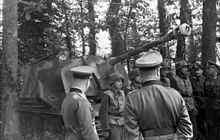
Hotchkiss H39 based GW H39 7.5 cm Pak 40 under review, May, 1944
-

Panzergrenadiers of 21st Panzer are reviewed before their leSPW U304(f) near Rouen
-

Men of the 6th Airborne investigate a destroyed 7.5 cm PaK40/1 auf Geschuetzwagen
Becker Conversions

- Fully tracked armoured fighting vehicles
- Conversions based on the Lorraine 37L light tractor
- 7.5 cm PaK40/1 auf Geschuetzwagen Lorraine Schlepper (f)
- The Marder I, a 75 mm Pak 40 mounted on the chassis of a Lorraine light tractor to function as a self-propelled anti-tank gun.
- 10.5 cm leFH18(Sf) auf Geschuetzwagen Lorraine Schlepper(f)
- The 105 mm howitzer mounted on the Lorraine tractor, an equivalent to the Wespe
- 15 cm sFH13/1 (Sf) auf Geschuetzwagen Lorraine Schlepper(f)
- The 150 mm sFH 18 howitzer mounted on the Lorraine tractor, an equivalent to the Bison or Grille
- Beobachtungswagen auf Lorraine Schlepper(f)
- A command and artillery observation vehicle.
- 12.2 cm Kanone (r) auf Geschuetzwagen Lorraine(f)
- A single conversion mounting the Soviet 122 mm howitzer onto this same chassis.
- Gefechtsfeld-Versorgungsfahrzeug Lorraine 37L(f)
- An armoured munitions carrier.
- Munitionstransportkraftwagen auf Lorraine Schlepper
- An armoured munitions transporter.
- Conversions based on the Hotchkiss H35 and H 39 light tank
- 10,5 cm leFH18(Sf) auf Geschützwagen 39H(f)
- The 105 mm howitzer mounted on the chassis of the Hotchkiss H 39 light tank, an equivalent to the Wespe
- Panzerkampfwagen 35H(f) mit 28/32 cm Wurfrahmen
- Artillerieschlepper 38H(f)
- The Hotchkiss H 38 converted to pull artillery.
- 7,5 cm PaK40(Sf) auf Geschützwagen 39H(f)
- The 75 mm Pak 40 mounted on the chassis of the Hotchkiss H 39 light tank
- Halftrack conversions to armoured troop or weapons carriers
- Zugkraftwagen S303(f) - Softskin half-track, based on the Somua MCL halftrack.
- Zugkraftwagen S307(f) - Softskin half-track, based on the Somua MCG halftrack.
- mSPW S303(f)(Pionier) - armoured personnel carrier halftrack based on the Somua MCL. Equivalent of the Sdkfz 251/7 Pionierpanzerwagen: an assault engineer vehicle with fittings to carry assault bridge ramps on the sides.
- mSPW S307(f) - armooured personnel carrier halftrack based on the Somua MCG. Equivalent of the Sdkfz 251/1.
- mSPW S307(f) (7.5cm PaK 40) - Equivalent of the Sdkfz 251/22 - an armoured version of the Somua half-track, mounting the 75mm PaK 40.
- 8cm Vielfachwerfer auf SPW Somua S303 (f), Mounting two racks of ten 8cm ‘Stalin’s Organ’ Katyusha Rockets (or German copies thereof), 6 produced
- 8cm Schwerer Reihenwerfer auf SPW Somua S303 (f) based on the Somua MCL, 20x 81mm French Brandt mortars on a single mount, 16 produced
- 8cm Leichter Reihenwerfer auf SPW Somua S307 (f) based on the Somua MCG, 16x 81mm French Brandt mortars on a single mount, 36 produced
- Unic P-107 Several hundred of these were armoured to convert them to the U304(f) armoured personnel carriers.
- Zugkraftwagen P107/304(f) - Softskin half-track, based on the Unic P107 halftrack.
- leSPW U304(f) - armoured personnel carrier variant of the P107 - similar to the Sd.Kfz. 251 series.
- leSPW U304(f) (Fkl) - Equivalent of the Sdkfz 251/3 or 251/8 radio/command vehicles.
- leSPW U304(f) (2cm FlaK 36) - Equivalent of the Sdkfz 251/17, mounting the 20mm Flak 36.
- leSPW U304(f) (3.7cm PaK 36) - Equivalent of the Sdkfz 251/10, mounting the 37mm PaK 36.
- leSPW U304(f) (8cm GrW) - Equivalent of the Sdkfz 251/2, mounting the 8cm mortar
References
- Notes
- ↑ Of the thirty vehicles shipped, seven were lost in transit when their cargo vessel was sunk. Twenty-three arrived safely and were put into use by the Afrika Korps.
- ↑ Feuchtinger had organized the annual Nuremberg (Nazi) party rallies in the 1930s and held his command for political reasons. He had commanded a horse-drawn artillery regiment on the Eastern Front in 1942 but had no experience in leading armored units prior to assuming command of the 21st Panzer.[13]
- Citations
- ↑ 1.0 1.1 1.2 1.3 1.4 1.5 1.6 Restayn, Jean Kommando Becker. German Military Magazine (in German)(see External Links)
- ↑ Divisional organization of 21st Panzer Division, June 1944
- ↑ Mitcham (1985) p. 5
- ↑ 4.0 4.1 4.2 Mitcham (1985) p. 279
- ↑ "Altmärkische Kettenwerke". Deutsch Wikipedia.
- ↑ 6.0 6.1 "Gw. Lr. S. 15 cm sFH 13 (on French Lorraine chassis), Catalog of Enemy Ordnance". U.S. Office of Chief of Ordnance. 1945.
- ↑ Lefèvre p. 196
- ↑ 8.0 8.1 8.2 8.3 U.K. Collections, film archive, Alfred Becker
- ↑ "Marder I (Panzerjaeger Lr S 7,5 cm Pak 40/1 on French chassis), Catalog of Enemy Ordnance". U.S. Office of Chief of Ordnance. 1945.
- ↑ "Ammunition carrier (on French Lorraine chassis), Catalog of Enemy Ordnance". U.S. Office of Chief of Ordnance. 1945.
- ↑ Glantz
- ↑ Bernage p. 57
- ↑ 13.0 13.1 Mitcham (1997) pp. 43-46
- ↑ 14.0 14.1 14.2 Keegan p. 209
- ↑ 15.0 15.1 Luck p. 167
- ↑ Keegan p. 202
- ↑ Fowler p. 12
- ↑ Buffetaut p. 22
- ↑ Bernage p. 70
- ↑ Luck p. 194
- ↑ Luck p. 198
- ↑ Luck p. 200
- Bibliography
- Engelmann, Joachim and Scheibert, Horst. Deutsche Artillerie 1934-1945: Eine Dokumentation in Text, Skizzen und Bildern: Ausrüstung, Gliederung, Ausbildung, Führung, Einsatz. Limburg/Lahn, Germany: C. A. Starke, (1974) ISBN
- Bernage, Georges and Jean-Pierre Benamou, Goodwood: Bombardement géant anti-panzers. Editions Heimdal, (1994) ISBN
- Buffetaut, Yves, Les Grandes Batailles de la Seconde Guerre Mondiale, No. 12, La Campagne de Normandie. Histoire & Collections, Paris, France, (1994)
- Gander, Terry and Chamberlain, Peter. Weapons of the Third Reich: An Encyclopedic Survey of All Small Arms, Artillery and Special Weapons of the German Land Forces 1939-1945. New York: Doubleday, (1979) ISBN 0-385-15090-3
- Glantz, David The siege of Leningrad, 1941-1944: 900 days of terror. Zenith Imprint (2001) ISBN 0-7603-0941-8
- Hogg, Ian V. German Artillery of World War Two. 2nd corrected edition. Mechanicsville, PA: Stackpole Books, 1997 ISBN 1-85367-480-X
- Keegan, John Six Armies in Normandy: from D-Day to the liberation of Paris, June 6th-August 25th, 1944. New York, Viking Press (1982) ISBN 0 14-02-3542-6
- Lefèvre, Eric, Panzers in Normandy Then and Now. London, Battle of Britain International Ltd. (1990) ISBN
- von Luck, Hans Panzer Commander: The Memoirs of Colonel Hans von Luck. New York, Dell Publishing of Random House (1989) ISBN 0-440-20802-5
- Maerz, Dietrich The German Cross in Gold and Silver. Richmond, MI, B&D Publishing LLC, (2009) ISBN 978-0-9797969-2-0
- Mitcham, Samuel W. Jr., The Desert Fox in Normandy. Praeger Publishers, Westport, Connecticut, (1997) ISBN
- Mitcham, Samuel German Order of Battle Volume One: 1st thru 290th Infantry Divisions in WWII. Mechanicsburg, PA : Stackpole Books (1985) ISBN 0 8117 3416 1
- Scheibert, Horst, Panzerjäger. Schiffer Publishing, Ltd., Atglen, PA, (1998) ISBN
- Spielberger, Walter J. Beute-Kraftfahrzeuge und Panzer der Deutschen Wehrmacht (En: Captured Halftracks and Tanks of the German Military). Stuttgart, Motorbuch Verlag, (1989) ISBN 3-613-01255-3
- Zetterling, Niklas Normandy, 1944: German military organization, combat power and organizational effectiveness. Winnipeg, Man., J.J. Fedorowicz Pub., (2000) ISBN 0921991 56-8
External links
- Axis History Forum: Major Alfred Becker
- Divisional organization of 21st Panzer Division, June 1944
- Feldgrau Forum (En: Fieldgrey Forum)
- Kommando Becker by Jean Restayn, German Military Magazine (German)
- Normandie-1944, L'été de la Liberté: Generalleutnant Edgar Feuchtinger. 21e Panzer Division (Wehrmacht)(in French) (En: Summer of Freedom: Lieutenant General Edgar Feuchtinger, 21st Panzer Division (Wehrmacht)
- Soldaten im Einsatz (En: Soldiers in Action)
- The Unic P 107 halftrack in German service in Normandy
- Spearhead 1944
- U.K. Collections, German film, Alfred Becker